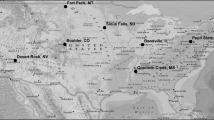Abstract
Refraction causes leveled height differences to be too small. It is usually considered to be the largest known systematic error in leveling measurements, amounting to as much as a cm/km. In 1937, long before refraction was widely accepted as a significant error source, T.J. Kukkamäki developed a correction which is proportional to the temperature difference, Δ t, between heights of 0.5 and 2.5m. Δ t was to be measured, requiring extra effort and equipment. Few countries adopted the correction, but it is now realized that the correction is necessary, especially in the middle and lower latitudes.
Removing refraction bias from old leveling measurements requires a temperature stratification model. The model described here is based on historical records of solar radiation, sky cover, precipitation, and ground albedo from many locations in the conterminous United States. The average difference between the predicted Δ t and observed Δ t is −0.12, +0.14, and −0,22 K for data sets from Maryland, California, and Arizona respectively. This modeling method can be adopted by any country with records of solar radiation. The model is an important asset to leveling computations because it provides a means of eliminating extreme refraction bias in the absolute heights and makes profiles of relative vertical movements more reliable. An economic advantage is realized by eliminating the need to observe vertical temperature profiles during most leveling surveys.
Similar content being viewed by others

Bibliography
P.V. ANGUS-LEPPAN, 1980: Refraction in leveling: extension to the stable and neutral atmospheric conditions. Proceedings of the Second International Symposium on Problems Related to the Redefinition of North American Vertical Geodetic Network, Canadian Institute of Surveying, Ottawa, Canada, May 26–30, 677–689.
P.V. ANGUS-LEPPAN. 1979: Refraction in leveling — its variation with ground slope and meteorological conditions, Australian Journal of Geodesy, Photogrammetry, and Surveying, No. 31, 27–41.
P.V. ANGUS-LEPPAN, 1971: Heat balance and refraction in the lower atmosphere. Proceedings of the Conference of Commonwealth Survey Officers, Cambridge, England, HMSO, 107–111.
P.V. ANGUS-LEPPAN, 1970: Heat balance and refraction in lower atmosphere. Proceedings of the Conference on Densification of Geodetic Networks, Budapest, Hungary.
F.K. BRUNNER, 1978: Experimental Determination of the Coefficients of Refraction from Heat Flux Measurements. Proceedings of the International Symposium, EDM, and Influence on Atmospheric Refraction, Richardus, P. (editor),Wageningen, Netherlands Geodetic Commission, 245-255.
F.K. BRUNNER and P.V. ANGUS-LEPPAN, 1976: On the significance of meteorological parameters for terrestrial refraction, Unisurv G25, University of New South Wales, Sydney, Australia.
Environmental Data Service, 1968, reprinted 1974: Climatic Atlas of the United States. U.S. Department of Commerce, Environmental Science Services Administration (now National Oceanic and Atmospheric Administration). National Climatic Center, Asheville, N.C. 28801.
E.L. DEACON, 1969: Physical processes near the surface of the Earth. World Survey of Climatology, 2 (General Climatology), Flohn, H. (editor), Elsevier, Amsterdam, Netherlands, 38–104.
A.J. DYER, 1974: A review of flux-profile relationships, Boundary-Layer Meteorology, 7, 363–374.
C.S. FRASER, 1977: The empirical determination of sensible heat flux for refraction correction, Unisurv G27, University of New South Wales, Sydney, Australia, 42–51.
R. GEIGER, 1975: The Climate Near the Ground. Harvard University Press, Cambridge, Mass.
E. HYTONEN, 1967: Measuring of the refraction in the second leveling in Finland. Publication of the Finnish Geodetic Institute, No. 63, Helsinki, Finland.
T.J. KUKKAMAKI, 1939: Formulas and tables for computation of leveling refraction. Publication of Geodetic Institute, No. 27, Helsinki, Finland.
E.C. KUNG, R.A. BRYSON, and D.H. LENSCHOW, 1964: Study of a continental albedo on the basis of flight measurements and structure of the Earth’s surface cover over North America, Monthly Weather Review, 92 (12).
R.J. POLAVARAPU, 1970: A comparative study of global and net radiation measurements at Guelph, Ottawa and Toronto, Journal of Applied Meteorology, 9, 809–814.
C.H.B. PRIESTLEY, 1959: Turbulent Transfer in the Lower Atmosphere. University of Chicago Press, 130 p.
N.J. ROSENBERG, 1974: Microclimate: The Biological Environment. John Wiley and Sons, New York, N.Y.
W.E. STRANGE, 1981: The impact of refraction correction on leveling interpretations in southern California, Journal of Geophysical Research, Vol. 86, 2809–2824.
E.K. WEBB, 1969: The temperature structure of the lower atmosphere. Proceedings of REF-EDM Conference. University of New South Wales, Sydney, Australia, 119.
E.K. WEBB, 1965: Aerial microclimate. Agricultural Meteorology, Meteorological Monograph 6 (28), Waggoner, P.E. (editor), 27–58.
C.T. WHALEN, 1980: Refraction errors in leveling: NGS test results. Proceedings of the Second International Symposium on Problems Related to the Redefinition of North American Vertical Geodetic Network, Ottawa, Canada, May, 757–782.
Author information
Authors and Affiliations
Rights and permissions
About this article
Cite this article
Holdahl, S.R. A model of temperature stratification for correction of leveling refraction. Bull. Geodesique 55, 231–249 (1981). https://doi.org/10.1007/BF02530864
Received:
Accepted:
Published:
Issue Date:
DOI: https://doi.org/10.1007/BF02530864



